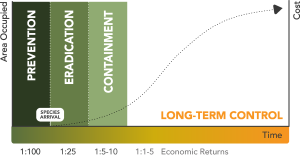March 4, 2024
By Morgan Lievers, Environmental Program Coordinator
An invasive species is when a non-native species is introduced to an area not naturally found and has the potential to cause harm to the environment. When conditions are favourable, invasive species are able to outcompete the native species. The common traits of successful invasive species are fast reproduction and growth rates, lack of predators, and native species with no defense against this new competitor.
Impacts of invasive species:
Aquatic Invasive Species (AIS), non-native plants and animals, are making their way into Alberta’s waterways. Within the Battle River and Sounding Creek watersheds no aquatic invasive species have been detected. Preventing the spread of these species into lakes, rivers, and streams in these watersheds will protect our drinking water sources, recreational opportunities, biodiversity, and irrigation for food production.
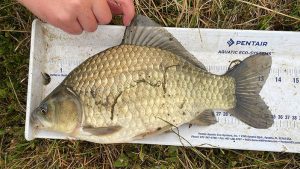
Originating from Europe and China, prussian carp were suspected to be introduced from an illegal pet release but it is unknown how they arrived in Alberta. Currently they are found in the Red Deer River, Bow River, and South Saskatchewan River. There have been none reported in the Battle River watershed. Often mistaken for a goldfish or common carp, the prussian carp can go undetected in areas allowing for successful establishment. Prussian carp are known as a bioturbator, which is a species that reworks soils while foraging for food. This fish species can live in areas with high turbidity and low oxygen levels. They have also adapted a way to reproduce asexually which allows their population levels to increase. A study found that the presence of prussian carp can decrease certain native fish species and benthic macroinvertebrates. A big part of their diet includes macroinvertebrates and their hunting habits increase turbidity causing unsuitable habitat. There are many knowledge gaps about the true impacts of introduction. More needs to be done with monitoring expansion rates and potential barriers on active removal. Some organizations have started to use eDNA to detect a more comprehensive distribution of these species.
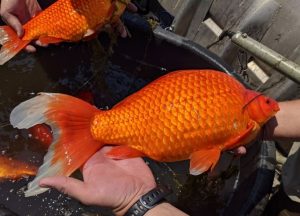
Goldfish are a common household pet, but many have been released into water bodies when families no longer want them. This has resulted in goldfish being found in over 70 locations all over Alberta. This species is known to grow based on the space available, so they might be small inside an aquarium but when released into the wild they can get up to 14 inches in length. At bigger sizes they will need to eat more and they possess similar destructive feeding habits to the prussian carp. Goldfish can survive in any quality of habitat as long as there is ample vegetation. Females can lay around 500-1000 eggs in a spawning period and even have the ability to hybridize with other carp species to increase their populations. Many control and management methods have been developed, but they are expensive and it is difficult to accomplish complete eradication. Some methods can include electroshock and netting to sort out the goldfish, or use of a pesticide that kills species with gills, but this can only be used in isolated water bodies with no other fish species.
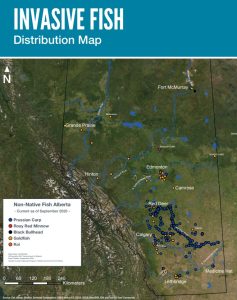
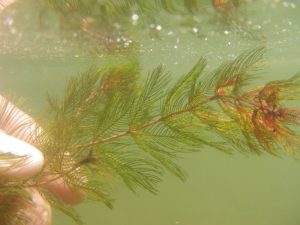
Introduced from Eurasia and North Africa through the release of ballast water in ships coming from those countries. Currently it is present in Ontario, Quebec and British Columbia. It spreads from recreational boats and other equipment that has not been cleaned properly between water bodies. Eurasian watermilfoil has seeds with poor germination rates, so it uses stem fragmentation and root runners to increase population. Root development can even start before it detaches from the parent stem allowing a colony to start from a single plant. These plants are also known to grow in a variety of substrates, except gravel, and are tolerant of low temperatures down to 15 degrees. Some of the possible management can include rototilling and harvesting, biological controls such as watermilfoil weevil, or use of herbicides. These controls are not long-term and few have been successful.
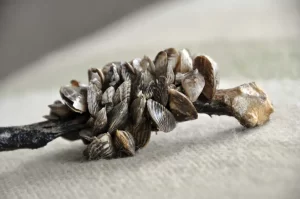
Zebra mussels are native to the Black and Caspian seas. They were introduced to North America through release of ballast water from ships as a result of the expansion of international trade. Currently they are found in Manitoba, Ontario, and Quebec. Native mussels are free living compared to the zebra mussels that attach to substrates. Zebra mussels attach themselves with byssal threads and can take as little as 6 months to completely cover an intake pipe. The small size of the mussels can allow them to go undetected on boats, and they can survive out of water for 30 days. Females are able to produce 40 thousand – 1 million eggs in one cycle allowing populations to increase exponentially. Zebra mussels are excellent filter feeders. A group of 700 thousand individuals can filter 2.5 million litres every 4 minutes leading to drastic ecosystem changes. With less algae present more sunlight can get through the water resulting in more plant growth. To prevent accidental introductions, boat inspection stations are used. There are only a few permanent stations in Alberta near the Saskatchewan and US borders.
Once an AIS is introduced, the cost of control increases as populations become more established as demonstrated in figure 2. Prevention and early detection is important to avoid the extra costs of long-term control. Public education programs increase awareness on how AIS can be spread is one of the major strategies in prevention. Clean, Drain, Dry and Don’t Let it Loose are some of the major programs that the government and other organizations promote. Early detection can help municipalities eradicate invasives more successfully. In Alberta, you can use EDDMapS (Early Detection and Distribution Mapping System) to submit possible invasive sightings and then an inspector will verify it. If no action is taken to control invasive species early on, then prevention and eradication turns into containment and long-term management. It takes public engagement and support to be successful in stopping the spread of any invasive species.
